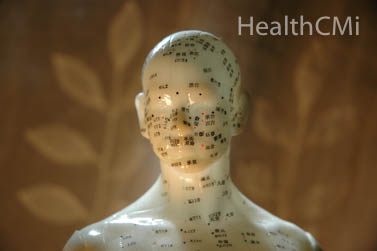Acupuncture provides therapeutic benefits for patients with vascular dementia. According to modern research, the benefits include improvements in memory, orientation, ability to make calculations, and increased ability for self-care. In a data mining meta-analysis, researchers have identified key acupuncture points with specific therapeutic benefits for patients with vascular dementia. 
A review of 238 acupuncture point prescriptions reveals the most frequently cited acupuncture points in modern publications for the treatment of vascular dementia:
- Baihui (GV20)
- Sishencong (EX-HN1)
- Fengchi (GB20)
- Shuigou (GV26)
- Shenting (GV24)
The most frequent acupuncture point combinations for vascular dementia treatment included the following acupoints:
- Baihui (GV20)
- Sishencong (EX-HN1)
- Fengchi (GB20)
- Shenting (GV24)
- Shuigou (GV26)
- Zusanli (ST36)
The researchers note that the “selection of acupoints plays a critical role in the therapeutic effects of acupuncture.” They add that the study indicates that acupoints GV20 and Sishencong are “priority” points for achieving clinical efficacy. Head, face, and neck acupuncture points are also indicated as high priority acupoints. The researchers indicate that GV20 was used the most frequently of all acupuncture points and has the highest therapeutic potential for the treatment of vascular dementia. In addition, GV20 is indicated as a primary acupuncture point for the treatment of intracerebral hemorrhage.
The researchers cite studies indicating several mechanisms by which GV20 exerts its therapeutic effects. GV20 increases dopamine levels in “chronic cerebral hypoperfusion and ischemia-reperfusion injured rats.” Dopamine serves several important functions within the body including acting as a neurotransmitter. Acupuncture at GV20 in combination with other acupoints reduces levels of 8-OHdG, a product of oxidative damage to DNA produced by free radicals. The researchers note that this indicates an antioxidant effect.

CREB (cAMP response element-binding protein) and BDNF (brain-derived neurotrophic factor) are important to humans for long-term memory storage capabilities. Acupuncture at GV20 upregulates both BDNF and CREB. Acupuncture plays an important role in cholinergic system regulation. A decrease in brain cholinergic function can lead to cognitive decline and reduced memory. The researchers note that acupuncture applied to GV20 “significantly increases the levels of choline acetyltransferase (ChAT) and restores the expression of choline transporter 1 (CHT1) and vesicular acetylcholine transporter (VAChT).”
The researchers note that acupuncture at GV20 and ST36 “preserves the integrity of the BBB (blood-brain barrier).” The blood-brain barrier is composed, in part, of occludin and claudin-5 that form an endothelial barrier made of tight junctions, connections between cell membranes absent usual spaces. A reduction of these biochemicals “contributes to BBB breakdown and edema in the ischemic brain.” Application of electroacupuncture to GV20 and ST36 “reduces brain damage and related behavioral deficits” by upregulation of tight junction proteins occludin, caludin-5, and ZO-1.
The investigators note that a clinical trial demonstrates that applying acupuncture to GV20, GV26, and HT7 is therapeutically effective for patients with vascular dementia. The specific clinical results are different per acupuncture point. GV20 improves “calculation ability and short-term memory” and also causes therapeutic correction of personality changes. GV26 causes improvements in “naming ability and short-term memory.” Both GV20 and GV26 were found clinically more effective than HT7.
A nuclear imaging study using PET (positron emission tomography) and SPECT (single photon emission computed tomography) reveal differing effects induced by needling GV20 and GV26. Acupuncture applied to GV20 “activated the inner temporal system, the thalamencephalon system, and the prefrontal cortical system” whereas acupuncture at GV26 “activated the prefrontal cortical system.” The researchers note that these results indicate the importance of specific acupuncture point selections for patients with vascular dementia. The researchers indicate that the frequent appearance in modern literature of acupuncture points GV20, Sishencong, GB20, GV26, GV24 for the treatment of vascular dementia may indicate superior clinical efficacy.
In related research, acupuncture is found to improve drug effectiveness for the treatment of Alzheimer’s disease (AD). The drugs included in the meta-analysis were donepezil, almitrine, raubasine, dihydroergotoxine, nimodipine, and piracetam. Four of the randomized controlled trials found acupuncture “superior to drugs.” Six randomized controlled trials found acupuncture combined with donepezil more effective than only donepezil. The researchers add “that acupuncture may be better than drugs and may enhance the effect of donepezil in term(s) of improving the cognitive function of AD patients.”
The two acupuncture points most frequently administered for the treatment of AD in the meta-analysis were GV20 and ST36. SP10 (Xuehai) and Sishencong were frequently administered. These acupuncture points are similar to those in the aforementioned research on the treatment of vascular dementia wherein GV20, ST36, and Sishencong are primary acupuncture point choices across multiple studies.
Laboratory results confirm the findings. Electron microscopy shows that hippocampal structures are preserved by the application of electroacupuncture and moxibustion. Acupuncture was applied to acupoints GV20 and BL23 (Shenshu) on laboratory rats with induced AD. The researchers note that “neuronal cell injury was markedly reduced” as a result of acupuncture.
References:
Feng, Shuwei, Yulan Ren, Shilin Fan, Minyu Wang, Tianxiao Sun, Fang Zeng, Ping Li, and Fanrong Liang. "Discovery of Acupoints and Combinations with Potential to Treat Vascular Dementia: A Data Mining Analysis." Evidence-Based Complementary and Alternative Medicine 501 (2015): 310591.
Zhou, Jing, Weina Peng, Min Xu, Wang Li, and Zhishun Liu. "The Effectiveness and Safety of Acupuncture for Patients With Alzheimer Disease: A Systematic Review and Meta-Analysis of Randomized Controlled Trials." Medicine 94, no. 22 (2015): e933.
Zhou, H., G. Sun, L. Kong, Y. Du, F. Shen, S. Wang, B. Chen, and X. Zeng. "Acupuncture and moxibustion reduces neuronal edema in Alzheimer's disease rats." Neural Regeneration Research 9, no. 9 (2014): 968.


